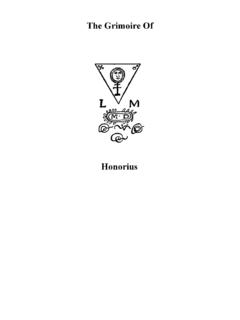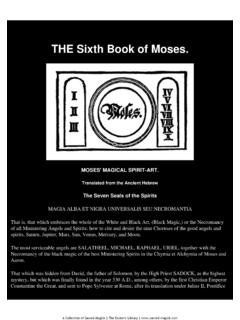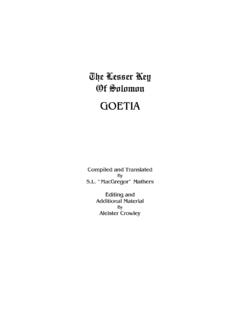Transcription of THE GUIDE FOR THE PERPLEXED - hermetics.org
1 THE GUIDE FOR THE PERPLEXED . BY MOSES MAIMONIDES. TRANSLATED FROM THE ORIGINAL ARABIC TEXT. BY M. FRIEDLANDER, SECOND EDITION. REVISED THROUGHOUT. 1904. Note: This book was scanned and ocr'ed by Andrew Meit and David Reed. CONTENTS. Life of Maimonides Moreh Nebuchim Literature. Analysis of the GUIDE for the PERPLEXED PART I. Introduction-- Dedicatory Letter The Object of the GUIDE On Similes Directions for the Study of this Work Introductory Remarks: I The homonymity of Zelem II On Genesis III On tabnit and temunah IV On raah, hibbit and hamb V On Exod. VI On ish and ishihah, ah and ahot VII On yalad VIII On makom IX On kisse X On 'alah, yarad XI On yashah XII On kam XIII On'amad XIV On adam XV On nazah, yazah XVI On Zur XVII On Mishnah Hagigah XVIII On karab, naga', niggash, XIX On male XX On ram, nissa XXI On 'abar XXII On ba XXIII On Yaza, sbub XXIV On halak XXV On shaken XXVI On "The Torah speaketh the language of man".
2 XXVII On Targurn of Gen. xivi. 4. XXVIII On regel XXIX On 'azeb XXX On akal XXXI, XXXII On the Limit of Man's Intellect XXXIII to XXXVI On the Study and the Teaching of Metaphysics XXXVII On panim XXXVIII On ahor XXXIX On leb XL On ruah XLI On nefesh XLII On hayyim-mavet XLIII On kanaf XLIV On 'ayin XLY On shama'. XLVI, XLVII On the Attribution of Senses and Sensation, to God XLVIII The Targum of shama' and raah XLIX Figurative Expressions applied to Angels L On Faith LI-LX On Attributes LI On the Necessity of Proving the Inadmissibility of Attributes in reference to God LII Classification of Attributes LIII The Arguments of the Attrilltists LIV On Exod.
3 Xxxiii. 13; xxxiv. 7. LV On Attributes implying Corporeality, Emotion, Non-existence and Comparison LVI On Attributes denoting Existence, Life, Power, Wisdom and Will LVII On the Identity of the Essence of God and His Attributes LVIII On the Negative Sense of the True Attributes of God LIX On the Character of the Knowledge of God Consisting of Negations LX On the Difference between Positive and Negative Attributes LXI On the Names of God LXII On the Divine Namea composed of Four, Twelve and Forty-two Letters LXIII On Ehyeh, Yab, and Shaddai LXIV On "The Name of the Lord," and" The Glory of God".
4 LXV On the phrase "God spake". LXVI On Exod. xxxii. 16. LXVII On shabat and nab LXVIII On the Terms : The Intellectus, the Intelligens and the Intelligibile LXIX On the Primal Cause LXX On the attribute rokeb ba'arabor LXXI The Origin of the Kalam LXXII A Parallel between the Universe and Man. LXXIII Twelve Propositions of the Kaldm LXXIV Proofs of the Kalkm for the creatio ex nihilo LXXV Proofs of the Kaldm for the Unity of God LXXVI Proofs of the Kaldm for the Incorporeality of God PART II. The Author's Introduction. The Twenty-Six Propositions employed by the Philosophers to prove the Existence of God I Philosophical proofs for the Existence, Incorporeality, and Unity of the First Cause II On the Existence of Intelligences or purely Spiritual Beings III The Author adopts the Theory of Aristotle as least open to Objections IV The Spheres and the Causes of their Motion V Agreement of the Aristotelian Theory with the Teaching of Scripture VI What is meant by the Scriptural Term "Angels".
5 VII The Homonymity of the term "Angel". VIII On the Music of the Spheres IX On the Number of the Heavenly Spheres X The Influence of the Spheres upon the Earth manifesto itself in four different ways XI The Theory of Eccentricity Preferable to that of Epicycles. XII On the Nature of the Divine Influence and that of the Spheres XIII Three Different Theories about the Beginning of the Universe XIV Seven Methods by which the Philosophers sought to prove the Eternity of the Universe XV Aristotle does not scientifically demonstrate his Theory XVI The Author refutes all Objections to Creatio ex nihilo XVII The Laws of Nature apply to Things Created.
6 But do not regulate the Creative Act which produces them XVIII Examinations of the Proofs of Philosophers for the Eternity of the Universe XIX Design in Nature XX The Opinion of Aristotle as regards Design in Nature XXI Explanation of the Aristotelian Theory that the Universe is the necessary Result of the First Cause XXII Objections to the Theory of the Eternity of the Universe XXIII The Theory of Creatio ex nihilo is preferable to that of the Eternity of the Universe XXIV Difficulty of Comprehending the Nature and the Motion of the Spheres according to the Theory of Aristotle XXV The Theory of Creation is adopted because of its own Superiority, the Proofs based on Scripture being Inconclusive XXVI Examination of a passage from Pirke di-Rabbi Eliezer in reference to Creation XXVII The Theory of a Future Destruction of the Universe is not part of the Religious Belief taught in the Bible XXVIII Scriptural Teaching is in favour of the Indestructibility of the Universe XXIX Explanation of Scriptural Phrases implying the Destruction of Heaven and Earth XXX Philosophical Interpretation of Genesis XXXI The Institution of the Sabbath serves (1)
7 To Teach the Theory of Creation, and (2) to promote Man's Welfare XXXII Three Theories concerning Prophecy XXXIII The Difference between Moses and the other Israelites as regards the Revelation on Mount Sinai XXXIV Explanation of Exodus xxiii. 20. XXXV The Difference between Moses and the other Prophets as regards the Miracles wrought by them XXXVI On the Mental, Physical and Moral Faculties of the Prophets XXXVII On the Divine Influence upon Man's Imaginative and Mental Faculties through the Active Intellect XXXVIII Courage and Intuition reach the highest degree of Perfection in Prophets XXXIX Moses was the fittest Prophet to Receive and Promulgate the Immutable Law, which succeeding Prophets merely Taught and Expounded XL The Test of True Prophecy XLI What is Meant by "Vision".
8 XLII Prophets Received Direct Communication only in Dreams or Visions XLIII On the Allegories of the Prophets XLIV On the Different Modes in which Prophets Receive Divine Messages. XLV The Various Classes of Prophets XLVI The Allegorical Acts of Prophets formed Parts of Prophetic Visions. XLVII On the Figurative Style of the Prophetic Writings XLVIII Scripture ascribes Phenomena directly produced by Natural Causes to God as the First Cause of all things PART III. The Author's Introduction and Apology for Publishing, contrary to the Teaching of the Mishnah, an Interpretation of Ezek.
9 I. I The "Four Faces" are Human Faces with four different peculiarities II The Hayyot and the Ofannim III Further Explanation of the Hayyot and the Ofannim derived from Ezek. x. IV The rendering of Ofan by Gilgal in the Targum of jonathan . V The Vision of Ezekiel is divided into three stages : (1) Hayyot (=. the Spheres); (2) Ofannim (=Earthly elements); and (3) the man above the Hayyot (=Intelligences). VI On the Difference between the Vision of Ezekiel and that of Isaiah (vi.). VII The Different Ways in which the Prophet perceived the Three Parts of the Mereabah (Chariot). VIII Man has the Power to Control his Bodily Wants and Earthly Desires IX The Material Element in Man Prevents him from Attaining Perfection X God is not the Creator of Evil XI Man is the Cause of his own Misfortunes XII Three Kinds of Evil : (1) That caused by the Nature of Man.
10 (2) Caused by Man to Man; (3) Caused by Man to himself XIII The Universe has No other Purpose than its own Existence XIV It is the Will of the Creator that the Spheres regulate the Affairs of Mankind XV Impossible Things are not ascribed to the Creator, but it in difficult to Prove the Impossibility in each Individual Case XVI On God's Omniscience XVII Five Theories concerning Providence XVIII Every Individual Member of Mankind enjoys the Influence of Divine Providence in proportion to his Intellectual Perfection XIX It is an ancient Error to Assume that God takes no Notice of Man XX God's Knowledge is Different from Man's Knowledge XXI The Creator's knowledge of His Production is Perfect XXII Object of the Book of job.






